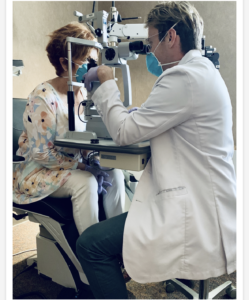
Dr. Vollmer with an emergency eyecare patient. He says that offering these services builds lifelong loyalty with patients.
Patrick Vollmer OD, FAAO
June 14, 2023
When a patient has a foreign body in their eye that needs to be removed, an uncomfortable infection, or when they know something is wrong, but don’t know what, they have an emergency. They require, or at least feel they require, immediate care. If your office can be the first place they turn to for that emergency care, you have created patients who will likely stick with you for life.
Here is how I am able to offer, and deliver, emergency care to patients, regardless of the day and time they need me.
Optimize Telemedicine
I don’t subscribe to a “minimum’ time” philosophy. I like to make myself available around the clock for my community (and surrounding communities). However, “being available” does not mean that I drop everything at once to inconvenience myself. This was a mistake I made early on in my career and it caused me to feel landlocked to an x-mile radius from my clinic at all times.
Coding for Telemedicine
During 2020 and the height of the COVID-19 pandemic, almost all optometric practices were closed down for at least a portion of the time. The only way to be seen for an office visit was via a telecommunication process.
The choices are:
Store and forward interaction (review of static information/pictures sent to doctor – text or e-mail photo)
Real-time audio only interaction (telephone)
Live, two-way interactions enhanced by the use of video or other data-transmission technology (patient portal video communication – HIPAA compliant)
The telemedicine process was so successful that there was a clamor not to remove virtual office visits. CMS has agreed to allow telemedicine services through December 31, 2023. This includes both the 92XXX and 99XXX codes. The only additional information added to the virtual visits are the modifiers.
Modifier -93 must be appended to applicable exam codes indicating to Medicare Part B that the exam was performed via audio only telemedicine.
Modifier -95 must be appended to applicable exam codes indicating to Medicare Part B that the exam was performed as telemedicine services.
Claims will continue to be billed with the place-of-service code that would be used had the services been furnished in-person. —Mark K. Davis, OD
With the rise of telemedicine, I am able to effectively communicate and treat emergency patients without necessarily having to see them in the clinic after hours. I have found that patients often just want a professional to talk to, and to be reassured.
For example, a patient with a subconjunctival hemorrhage almost never needs to be seen, but this is a stress call that I get from a patient almost every weekend. Simply talking to the patient on the phone, having them send pictures of their eye, and reassuring them, works wonders and requires little time for the doctor on call.
I utilize telemedicine for both new and existing patients. Most of the calls I get after hours such as styes, subconjunctival hemorrhages, certain conjunctivitis’, etc., do not necessitate me dropping what I am doing to rush to my clinic. I have had two emergency calls as I write this article. One was a dramatic subconjunctival hemorrhage and the other was an ocular allergy flare-up. I did not leave my house in Charlotte to see any of these patients, and they were beyond happy that I could talk to them about the conditions they were dealing with.
Use a Call-Forwarding System
We have a call-forwarding system in my clinic. A patient with an after-hours emergency can call my clinic and “press 1” for the call to go straight to my personal cell phone. If I am not near my phone to answer it, the patient can leave a message and I almost always get back to them within 15 minutes.
I will just call the patient from my phone and chat with them. Often, I ask the patient to text me a picture of their eye, so I can better see what ailment they are referring to. I was in Switzerland last summer, and the patient was amused (and relieved) that their doctor was answering their concerns from Europe. I know that many doctors are hesitant to give patients their personal numbers, and I can understand that in some ways. But in the six years I have been taking calls, I have never had a problem with phone abuse/constant disruption. Patients realize their doctor’s time is valuable, and I can’t produce a single example where that hasn’t been the case.
Create a Foreign Body Removal Kit
I always like to have a foreign body kit, an angle closure kit and an OCT available to me when treating emergency patients. Aside from the OCT, the other items are inexpensive. I can remove almost all of my patients’ foreign bodies with a golf club spud, but I do occasionally use an Alger brush if absolutely necessary. In patients with flashes and floaters, I always like to do large sweeping scans of the macula to make sure there are no proximity tears to the fovea.
Other Articles to Explore
If we leave the OCT out of the equation, providers can feel they are offering superb emergency care with a minimal cost burden to them.
Forge Relationships with Hospital ER Doctors & PCPs
As a sole provider coming straight out of my residency, and starting a practice relatively cold, I had plenty of time during the day to leave my clinic to tell other medical professionals about the services I offered. I visited their clinics and offices early and often when I first started my private practice career. To somewhat my amazement, many medical professionals have no idea of the scope of services that ODs can offer them. Many medical professionals still believe ODs can only prescribe contacts and glasses.
Years later, many send their own family members to me for emergency services. It’s nice looking back to see how the paradigm has shifted among the healthcare professionals I know, thanks to my deliberate attention. Consistency in telling both your own patients and your community the broad services you offer is the key.
Make the Most of Practice-Growth Opportunity of Providing Emergency Care
Most of my calls after hours are from patients who are not established in my clinic. I always ask how they heard of me, and they almost always mention a friend or family member who recommended me. I always thought that was a nice sentiment–that I was making an impression beyond those whom I have a current relationship with.
Once I assist an after-hours patient in need, they almost always switch their care (and their family’s care) over to me as their provider. Sometimes the revenue differences we make are not immediately felt, but are present for years to come.
 Patrick Vollmer OD, FAAO, is the owner of Vita Eye Clinic in Charlotte, N.C. To contact him: patrickvollmer23@gmail.com
Patrick Vollmer OD, FAAO, is the owner of Vita Eye Clinic in Charlotte, N.C. To contact him: patrickvollmer23@gmail.com

























